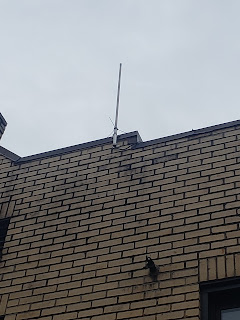I recently was called to look at and take over seven (7 )Buildings Fire Alarm Systems after they experienced constant problems with their Two (2 ) Way AES Radio Systems which report an active Fire Alarm Signal to a Central Station.
AES makes an excellent supervised wireless radio system that runs on its own UHF Channels and are deployed world wide. but the problems at these buildings was the radios where not properly installed particularly the Antenna set ups and when you live in a city full of Hills and Valleys like Pittsburgh Pa. that's important .
I replaced all the AES Radios with Napco Starlink Cellular Radios as I am not an AES dealer and you need to set up an entire network for it to work so only larger alarm company's can usually afford these systems.
 |
There are very specific specifications which must be met so these units will operate at peak efficiency and this was not done .
From the AES Manual
AES 7788 Series RF Subscriber Unit ─ Installation and
Operation Manual
AES Corporation 11 40-7788, Rev 6, August 30, 2016
1.11 Coaxial Cable and Antenna Installation Tips
· Avoid using 25’ of coax
length if a 10’ will be sufficient.
· Never use more than 25’
of RG-58 cable in any antenna installation
· Always use shortest
length of coax possible. Longer than necessary coax lengths
translates into greater signal loss.
· Always use the
straightest most direct routing possible in any coax installation.
Unnecessary and tight bends adds to potential signal loss.
· Use 50 Ohm impedance coax
only. Do not use 75 Ohm coax for the connection of
remote antenna. RG-8, 9913, LMR-400, LMR-600 and RG-58 are among a list of
acceptable 50 Ohm coax.
RG-59 and RG-6 are 75 Ohm and NOT to be used.
· Use the proper coaxial
connectors and crimp tool for the coax selected. Incorrect or
poorly installed connectors can have a significant effect of the performance of
the RF
The reason for this is when you couple an antenna to a radio you must maintain as close as possible a SWR of 1:1 anything past a 1:3 and problems will occur including burning out the transmitter
SWR stands for Standing Wave Ratio
https://en.wikipedia.org/wiki/Standing_wave_ratio
Clearly these installers failed to follow the instructions and as a result management was getting called for Radio trouble signals at all hours of the day and when they called for service and techs would come out to service the system they did nothing to fix it and charged the customer big bucks so you can understand the situation and why they called me.
Take the following pictures as some of the bad practices I saw
As you can see in this picture install instructions where violated when a section of coax was added to a system which is not allowed and then where it is coupled together a poorly sealed connector with tape is allowing water to get into it .
This building in particular the local fire Marshal thanked me for taking over because he was so upset with the company who installed and serviced the radios due to all the calls they would get from tenants when the systems would start beeping in trouble all times of the day.
This was all 100% avoidable.
Had they hired someone like me who is familiar with Two( 2) way and Amateur ( Ham ) Radio Equipment to scope out and test for best placement of the antennas instead of just do what you have to to get a signal .
Needless to say i will be picking up more of these buildings from this customer because they have had it with the current alarm provider.
 |
| antenna shoved thru hole in ceiling |
 |
| antenna shoved thru drilled hole in soffit |



No comments:
Post a Comment